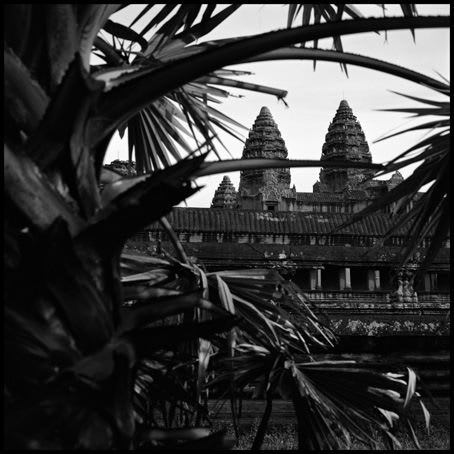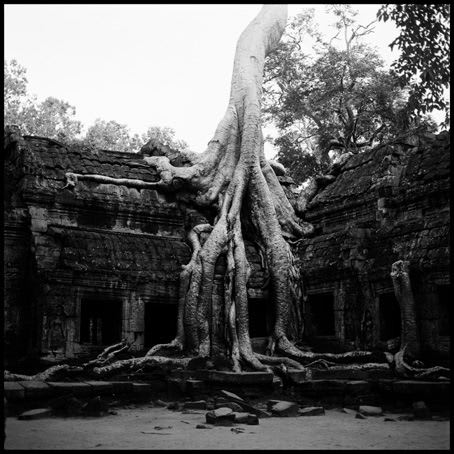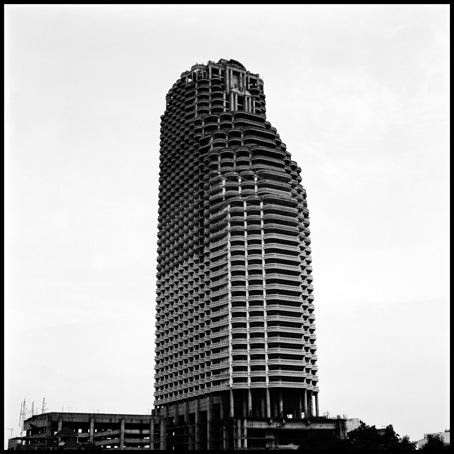Jane Burton: The Fall
Jane Burton has travelled to an ancient lost city, a place so fabulous it seems more the stuff of dreams than an actual location. But these beautifully composed photographs, where the ecstatic architectural forms of a forgotten civilisation crumble back into nature or submit to the jungle’s embrace, prove that it is real.
Through the centuries, before photography, a mere handful of people had stumbled across this remote enchanted city of colossal stone palaces and temples, all but hidden in the engulfing jungle. Their rapturous reports of it were not believed. One indeed described it as a mirage, confessing himself ‘intoxicated by the delirious maze that piles its complications to the sky . . . the great strange towers entwined with exotic branches’. These felicitous words are apt accompaniments to Burton’s photographs, The Fall 2, 3 and 12.The first recreates a sense of how it must have felt to suddenly encounter this magical place looming out of the jungle, the vigorous rapier-like growth of tropical vegetation cutting across the mystical forms of lotus-bud towers. In the two other photographs, the eerie light of an approaching storm intensifies the mirage-like quality of towering time-ravaged stones encrusted with intricate carvings.
One of the great pleasures of these photographs is their range of textures. After standing back and enjoying the grand view of the large format, closer inspection reveals the texture of the stone and hence some of the details of the carvings and bas reliefs: giant hieratic faces hewn into rock; walls vibrant with dancing apsaras; stone lions and the serpent forms of nagas standing guard.
In recent years Burton has achieved acclaim for her suites of photographs that juxtapose female nudes with shots in various outdoor locations, presenting the viewer with the pleasurable challenge of identifying linkages in a hidden narrative. In The Fall these connections have become more subtle and pervasive. ‘Abandoned’ is an unspecified constant in Burton’s work. The nudes are shot in abandoned houses; the lost city was famously and mysteriously abandoned for centuries; even the contemporary skyscraper, its ziggurat pinnacle echoing the lotus-bud forms of the ancient temples, is abandoned. The word carries connotations of loss, fear even, but for an art photographer, abandoned places are sites of heady excitement. After the initial thrill of trespass, these places in their solitude offer the intruder an exclusive, one-on-one relationship, promising discovery of time-locked secrets, or acting as an almost neutral setting for projections of the mind. Freed from the inhabited world of the familiar, the creative imagination is released to engage with the unknown territory of the subconscious and the place itself.
Returning from her overseas trip, Burton sought out her unknown rooms and shot this present series of nudes. For all their sophisticated, elegant sensuality, the lyrical grace of their forms, there is a primal quality to these darkly silhouetted presences basking in light: some essence of female. Burton said, “I photographed the figure so that it could be like an ancient idol carved out of stone, not a contemporary figure”. The strong stance of these figures suggests they have been standing there for all eternity, like the imperious stone devata (goddess) flanked by dancing apsaras in The Fall 7. And by photographing flesh through the net of a curtain, as in The Fall 4, for example, she creates a texture that has the semblance of stone. The graceful attitude of the arm in this figure, the curve of her fingers, echoes the beguiling movements of the smiling apsaras.
Burton is well aware of how loaded photographs of the female nude can be. The balance she strikes between the beauty and sensuality of the female form, and a sense of the intact, perhaps inviolable, interior world of her characters and the power this confers upon them, is her singular achievement as a photographer of the nude. It is particularly the case with this new work that her women are the desirers, not merely the desired. She has conjured up images serenely suggestive of the female desire for ecstasy.
How has she done this? Through graceful positioning and her expert handling of natural light. The palpable presence of white-hot light in The Fall 1 reminds me of famous paintings where Zeus appears as a blinding shower of golden light to Danae as she lies outstretched, waiting to be ravished by him. On the right of the photograph, the light mingles with the net curtain and its shadow of leaves, creating a brocaded pattern of light and shade, again recalling the paintings and their luxurious textiles. Light is the ubiquitous motif in these nudes, moving toward the figures, caressing them, stroking the silky inside of a thigh, penetrating them. The figure in The Fall 6 is so penetrated by it, so enwrapped, that she shudders near a point of merging with it and abstracting herself.
Burton also puts light to use as a unifier. The shape of the sunlit landscape in The Fall 13 correlates inversely with that of the dark figure in The Fall 14. Light interacting with tiles, window panes, the slats of Venetian blinds, the circular pattern on a curtain, creates subtle interplays of geometry between the nudes, the skyscraper, the ancient steps, the stone goddess, all pointing to the sacred geometry of the lost capital’s magnificent structures. The visitor who crosses the causeway over the wide moat, passing through the main entrance and traversing the courtyards to the main tower between the elephant gates, is metaphorically travelling back in time to the creation of the universe.
The French naturalist credited with the ‘discovery’ of this forgotten place – he was actually the first person to have his reports of it believed back home – asked a local who had made it. The reply was, “It made itself”. Looking at the massive temple mountains in these images, imagining their dark labyrinthine interiors with their endless staircases and galleries, and sensing the intense heat of this place, its humid fecundity, one can almost believe it.
Victoria Hammond, November 2004
-
 Jane BurtonThe Fall 1, 2004Type C photograph112 x 112cmEdition of 5 plus 1 artist's proofSold
Jane BurtonThe Fall 1, 2004Type C photograph112 x 112cmEdition of 5 plus 1 artist's proofSold -
 Jane BurtonThe Fall 2, 2004Type C photograph112 x 112cmEdition of 5 plus 1 artist's proofAU$ 5,000.00 + framing
Jane BurtonThe Fall 2, 2004Type C photograph112 x 112cmEdition of 5 plus 1 artist's proofAU$ 5,000.00 + framing -
 Jane BurtonThe Fall 3, 2004Type C photograph112 x 112cmEdition of 5 plus 1 artist's proofAU$ 5,000.00 + framing
Jane BurtonThe Fall 3, 2004Type C photograph112 x 112cmEdition of 5 plus 1 artist's proofAU$ 5,000.00 + framing -
 Jane BurtonThe Fall 4, 2004Type C photograph112 x 112cmEdition of 5 plus 1 artist's proofSold
Jane BurtonThe Fall 4, 2004Type C photograph112 x 112cmEdition of 5 plus 1 artist's proofSold -
 Jane BurtonThe Fall 5, 2004Type C photograph112 x 112cmEdition of 5 plus 1 artist's proofAU$ 5,000.00 + framing
Jane BurtonThe Fall 5, 2004Type C photograph112 x 112cmEdition of 5 plus 1 artist's proofAU$ 5,000.00 + framing -
 Jane BurtonThe Fall 6, 2004Type C photograph112 x 112cmEdition of 5 plus 1 artist's proofAU$ 5,000.00 + framing
Jane BurtonThe Fall 6, 2004Type C photograph112 x 112cmEdition of 5 plus 1 artist's proofAU$ 5,000.00 + framing -
 Jane BurtonThe Fall 7, 2004Type C photograph112 x 112cmEdition of 5 plus 1 artist's proofAU$ 5,000.00 + framing
Jane BurtonThe Fall 7, 2004Type C photograph112 x 112cmEdition of 5 plus 1 artist's proofAU$ 5,000.00 + framing -
 Jane BurtonThe Fall 8, 2004Type C photograph112 x 112cmEdition of 5 plus 1 artist's proofAU$ 5,000.00 + framing
Jane BurtonThe Fall 8, 2004Type C photograph112 x 112cmEdition of 5 plus 1 artist's proofAU$ 5,000.00 + framing -
 Jane BurtonThe Fall 9, 2004Type C photograph112 x 112cmEdition of 5 plus 1 artist's proofAU$ 5,000.00 + framing
Jane BurtonThe Fall 9, 2004Type C photograph112 x 112cmEdition of 5 plus 1 artist's proofAU$ 5,000.00 + framing -
 Jane BurtonThe Fall 10, 2004Type C photograph112 x 112cmEdition of 5 plus 1 artist's proofAU$ 5,000.00 + framing
Jane BurtonThe Fall 10, 2004Type C photograph112 x 112cmEdition of 5 plus 1 artist's proofAU$ 5,000.00 + framing -
 Jane BurtonThe Fall 11, 2004Type C photograph112 x 112cmEdition of 5 plus 1 artist's proofAU$ 5,000.00 + framing
Jane BurtonThe Fall 11, 2004Type C photograph112 x 112cmEdition of 5 plus 1 artist's proofAU$ 5,000.00 + framing -
 Jane BurtonThe Fall 12, 2004Type C photograph112 x 112cmEdition of 5 plus 1 artist's proofAU$ 5,000.00 + framing
Jane BurtonThe Fall 12, 2004Type C photograph112 x 112cmEdition of 5 plus 1 artist's proofAU$ 5,000.00 + framing -
 Jane BurtonThe Fall 13, 2004Type C photograph112 x 112cmEdition of 5 plus 1 artist's proofAU$ 5,000.00 + framing
Jane BurtonThe Fall 13, 2004Type C photograph112 x 112cmEdition of 5 plus 1 artist's proofAU$ 5,000.00 + framing -
 Jane BurtonThe Fall 14, 2004Type C photograph112 x 112cmEdition of 5 plus 1 artist's proofSold
Jane BurtonThe Fall 14, 2004Type C photograph112 x 112cmEdition of 5 plus 1 artist's proofSold -
 Jane BurtonThe Fall 15, 2004Type C photograph112 x 112cmEdition of 5 plus 1 artist's proofAU$ 5,000.00 + framing
Jane BurtonThe Fall 15, 2004Type C photograph112 x 112cmEdition of 5 plus 1 artist's proofAU$ 5,000.00 + framing
















